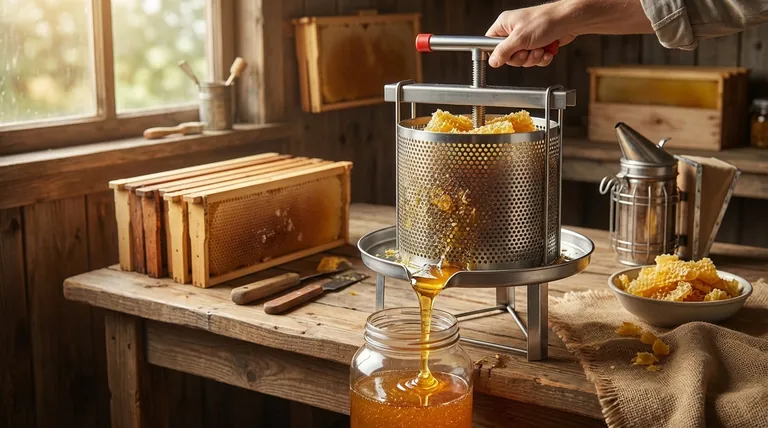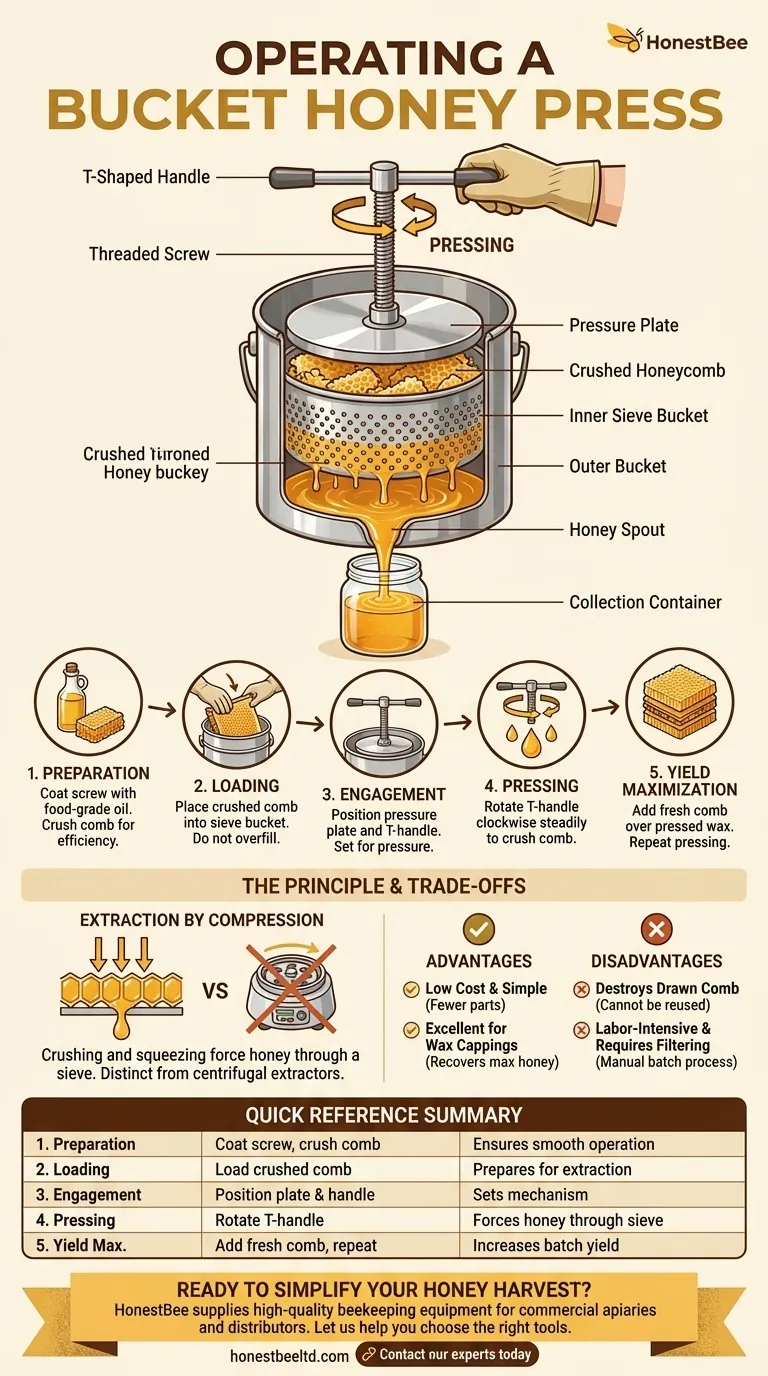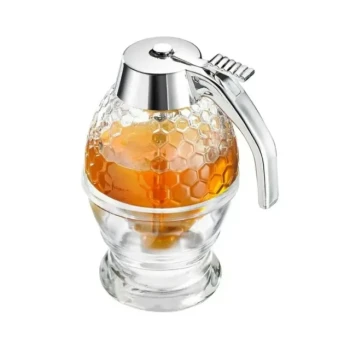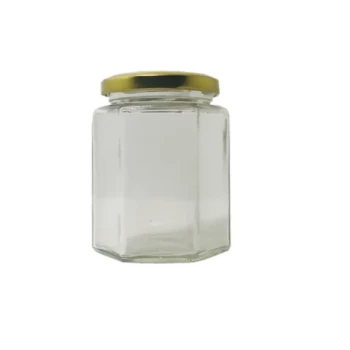To operate a bucket honey press, you first place cut or crushed honeycomb into the inner sieve bucket. You then position the pressure plate and handle, and rotate the T-shaped handle clockwise to apply downward force. This pressure crushes the comb, forcing the honey through the sieve and out of a spout into a collection container below.
The honey press is a simple, effective tool for small-scale beekeepers. Its value lies not in speed, but in its ability to extract honey through direct pressure, making it ideal for processing wax cappings and comb honey without the expense of a centrifugal extractor.

The Principle: Extraction by Compression
A bucket honey press works on a straightforward principle: crushing and squeezing. This is fundamentally different from a centrifugal extractor, which uses spinning force to sling honey out of the comb cells.
The Inner Sieve Bucket
The core of the press is a perforated or mesh-lined inner bucket. This bucket holds the honeycomb but allows the liquid honey to pass through when pressure is applied, leaving the solid beeswax behind.
The Pressure Mechanism
A T-shaped handle connects to a long screw. As you turn the handle, the screw drives a solid pressure plate downward onto the honeycomb. The mechanical advantage of the screw allows you to generate immense force with minimal effort.
The Pressing Process: A Detailed Walkthrough
Proper preparation and technique will maximize your yield and minimize cleanup. For best results, secure the press by clamping or bolting it to a sturdy table.
Step 1: Prepare the Press and Comb
Before your first press of the season, lightly coat the screw mechanism with a food-grade oil or grease. This ensures smooth operation and prevents binding under pressure.
For the comb itself, breaking it up or roughly crushing it before loading it into the basket will make the pressing more efficient.
Step 2: Load the Sieve Bucket
Place your crushed honeycomb or wax cappings into the inner sieve bucket. Do not overfill it; leaving some space at the top is crucial for the pressure plate to work effectively.
Step 3: Engage the Press
Position the pressure plate on top of the comb. Press down on the T-shaped handle to set it in its ready position and begin tightening the screw until you feel it make firm contact with the plate.
Step 4: Apply Consistent Pressure
Rotate the T-shaped handle clockwise. You will feel resistance as the comb begins to compress. Go slowly and steadily, giving the honey time to flow through the sieve and out the collection spout.
As the honey flow slows, you can often get more out by continuing to tighten the handle in small increments.
Step 5: Maximize Your Yield
A common technique is to press in batches without emptying the wax. After the first press, add another layer of fresh comb on top of the compressed wax puck and press again. You can often repeat this two or three times before the bucket is full of dry, pressed wax.
Understanding the Trade-offs
While simple, a honey press is not the right tool for every situation. Its strengths in some areas are weaknesses in others.
Advantage: Cost and Simplicity
A press is significantly less expensive and has fewer moving parts than a centrifugal extractor. It is an excellent entry-level tool for hobbyists with a small number of hives.
Advantage: Processing Wax Cappings
Presses are exceptionally good at squeezing the last drops of honey from wax cappings, which are cut off the frames before extraction. This makes them a valuable companion tool even for beekeepers who own an extractor.
Disadvantage: Destructive to Comb
The primary drawback is that this method destroys the beeswax comb. Bees expend significant energy to draw out comb, and reusing it saves them weeks of work. A press renders the comb into a block of wax, which cannot be reused in the hive.
Disadvantage: Labor and Filtering
Pressing is a manual, batch-based process that is more labor-intensive per frame than using an extractor. The process also tends to incorporate more fine wax particles into the honey, often requiring an extra stage of filtering or settling before bottling.
Making the Right Choice for Your Goal
Use your primary objective to determine if a press is the correct tool for you.
- If your primary focus is low-cost extraction for a few hives: A honey press is an excellent, cost-effective choice for processing both honey and cappings.
- If your primary focus is preserving drawn comb for reuse: A press is not suitable; you must use a centrifugal extractor to keep the comb intact.
- If your primary focus is efficiently processing wax cappings: A press is a highly effective tool for recovering the maximum amount of honey from cappings.
Choosing the right tool is the first step toward an efficient and rewarding honey harvest.
Summary Table:
| Step | Key Action | Purpose |
|---|---|---|
| 1. Preparation | Coat screw with food-grade oil; crush comb. | Ensures smooth operation and efficient pressing. |
| 2. Loading | Place crushed comb into the inner sieve bucket. | Prepares the comb for extraction without overfilling. |
| 3. Engagement | Position the pressure plate and T-handle. | Sets the mechanism for applying pressure. |
| 4. Pressing | Rotate the T-handle clockwise steadily. | Crushes the comb, forcing honey through the sieve. |
| 5. Yield Maximization | Add fresh comb on top of pressed wax and repeat. | Increases honey yield from a single batch. |
Ready to simplify your honey harvest? A bucket honey press is a perfect, cost-effective tool for hobbyists and small-scale beekeepers. At HONESTBEE, we supply high-quality beekeeping supplies and equipment to commercial apiaries and distributors. Let us help you choose the right tools for an efficient harvest. Contact our experts today to discuss your needs!
Visual Guide

Related Products
- Easy Use Manual Stainless Steel Honey Press for Honey Comb
- Electric Honey Press Machine for Squeezing Honey Comb Press Equipment
- Stainless Steel Manual Honey Press with Guard for Pressing Honey and Wax
- 10L Stainless Steel Electric Honey Press Machine
- HONESTBEE 3-Frame Manual Acrylic Honey Extractor
People Also Ask
- What is a honey press and how does it work? A Guide to Crush-and-Strain Extraction
- How does a honey press work? A Guide to Simple, High-Yield Honey Extraction
- What are the key features of a honey press? Maximize Yield with Durable, Efficient Extraction
- What are the two most popular types of machines for honey extraction? Choose the Right Tool for Your Apiary
- What are the reasons for choosing a honey press over a dedicated honey extractor? Maximize Disease Control and Natural Beekeeping



















